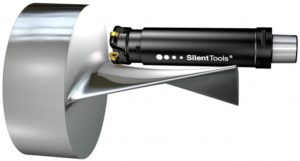HOW TO REDUCE VIBRATIONS IN MILLING
Vibrations during milling can be caused by restrictions on the cutting tool, holding tool, machine, workpiece or chuck. Several strategies need to be considered to reduce vibration.

Cutting tool
In face milling, the direction of the cutting forces must be taken into account:
- At 90 ° cutters, the predominant forces are focused in the radial direction. This creates a cutter deflection at long overhangs; low axial force is advantageous in milling thin-walled, vibration-sensitive components
- 45 ° cutters create evenly distributed axial and radial forces
- Cutters with round inserts direct most of the forces up the spindle, especially at small depths of cut. Also, 10 ° cutters transmit forces mainly to the spindle, which reduces vibrations caused by long tool overhangs.



- Select the smallest possible diameter for the operation.
- DC should be 20-50% greater than ae.
- Choose a coarse pitch cutter and / or a differential tilt cutter.
- An advantage is a low-weight cutter, such as a cutter with an aluminum housing.

For thin-walled unstable workpieces, use a large input angle = small axial cutting force.
For long tool overhangs, use a small input angle = large axial cutting force.
Tool holder
The modular tool holding system allows the tools to be assembled to the required length, while maintaining high stability and minimum leakage.
- The assembled tool should be as rigid and short as possible.
- Select the largest possible adapter diameter / size.
- Use adapters with large cutters to avoid reducers.
- For small cutters, preferably use a tapered adapter.
- For operations where the final transition is deep in the component, switch to extended tools at predetermined positions. Adjust the cutting data for each tool length.
- For spindle speeds above 20,000 rpm, use balanced cutting and holding tools.
Large cutter

Always use the shortest possible tool length.

Are you interested in milling services?
See our offer:
For all questions we are at your disposal:
Moistened silent cutters
With overhangs larger than four times the tool diameter, the tendencies of vibration during milling can become more apparent, and blurred cutters can significantly improve productivity.

Cutting edge of milling knife
To reduce cutting forces:
- You can choose the cutting geometry, -L, with a sharp edge and a degree with a thin coating.
- Use inserts with small corner radii and small parallel surfaces.
Sometimes adding more damping to the system can reduce vibration tendencies. Use a more negative cutting edge geometry and a slightly worn cutting edge.
Tool path programming and milling data
- Always place the cutter off-center with respect to the sanded surface.
- For cutting edges or end cutters KAPR 90 ° use low radial immersion: max ae = 25% DC and high axial cut: max ap = 100% De.
- For face milling, use a small depth of cut, ap and high feed rate, fz, with round inserts or high feed rate cutters with small entry angles.
- Avoid vibrations in the corners by programming a large path radius, see milling inside the corners.
- If the thickness of the chips becomes too low, the cutting edge will rub rather than the cutter, causing vibrations. In such cases, the displacement on the tooth should be increased.

Machine tools
The condition of the machine can greatly affect the tendency to vibrate when milling. Excessive wear on the spindle bearing or feed mechanism results in poor machining properties. Carefully select machining strategies and cutting force directions to take full advantage of machine stability.
Each spindle of the machine has natural areas that are prone to vibration. Areas of stable cutting are described as flap stability and increase with increasing speed. Even with a small increase, even at 50 rpm, the cutting process from unstable, with vibrations, can become stable.

Workpiece and its attachment
When milling components with a thin wall, substrate, and / or when the fastener is weak, note the following:
- The device must be close to the machine table.
- Optimize the tool path and feed direction towards the strongest machine / installation node to ensure the most stable cutting conditions.
- Avoid machining in directions where the workpiece is poorly supported.
- Upward milling can reduce the tendency to vibrate when the wiring and / or workpiece is weak in a certain direction.
For weak attachments, use the milling direction towards the machine table.

Note that the first step should be done at half the depth of the second, third, etc.

Source: Sandvik Coromant
